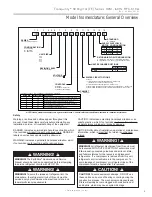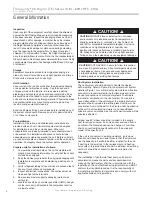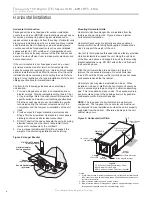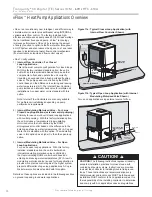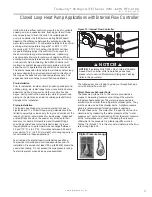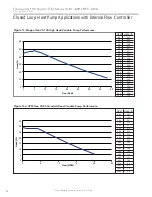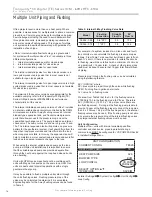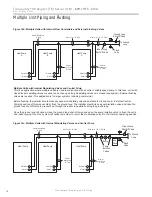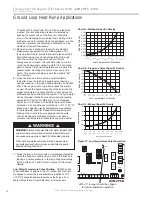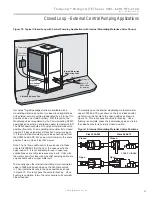
6
G e o t h e r m a l H e a t i n g a n d C o o l i n g
Tranquility
®
30 Digital (TE) Series IOM - 60Hz HFC-410A
R e v. : 2 9 M a y, 2 0 1 5 J
Horizontal Installation
Figure 4: Hanger Bracket
>PP@7KUHDGHG
5RGE\RWKHUV
9LEUDWLRQ,VRODWRU
IDFWRU\VXSSOLHG
:DVKHU
E\RWKHUV
'RXEOH+H[1XWV
E\RWKHUV
Horizontal Unit Location
Packaged units are not designed for outdoor installation.
Locate the unit in an INDOOR area that allows enough space
for service personnel to perform typical maintenance or
repairs without removing unit from the ceiling. Horizontal units
are typically installed in an attic or crawl space. Never install
units in areas subject to freezing or where humidity levels
could cause cabinet condensation (such as unconditioned
spaces subject to 100% outside air). Consideration should
be given to access for easy removal of the
fi
lter and access
panels. Provide suf
fi
cient room to make water, electrical, and
duct connection(s).
If the unit is located in a con
fi
ned space, such as a closet,
provisions must be made for return air to freely enter the
space by means of a louvered door or return duct. Any access
panel screws that would be dif
fi
cult to remove after the unit is
installed should be removed prior to setting the unit. Refer to
Figure 6 for an illustration of a typical installation. Refer to unit
catalog speci
fi
cations for dimensional data.
Conform to the following guidelines when selecting a
unit location:
1. Provide a hinged access door in concealed-spline or
plaster ceilings. Provide removable ceiling tiles in T-bar
or lay-in ceilings. Refer to horizontal unit dimensions for
speci
fi
c series and model in unit catalog speci
fi
cations.
Size the access opening to accommodate the service
technician during the removal or replacement of the
compressor and the removal or installation of the unit
itself.
2. Provide access to hanger brackets, water valves and
fi
ttings. Provide screwdriver clearance to access panels,
discharge collars and all electrical connections.
3. DO NOT obstruct the space beneath the unit with piping,
electrical cables and other items that prohibit future
removal of components or the unit itself.
4. Use a manual portable jack/lift to lift and support the
weight of the unit during installation and servicing.
Mounting Horizontal Units
Horizontal units have hanger kits pre-installed from the
factory as shown in Figure 4. Figure 6 shows a typical
horizontal unit installation.
Horizontal heat pumps are typically suspended above a
ceiling or within a sof
fi
t using
fi
eld supplied, threaded rods
sized to support the weight of the unit.
Use four (4)
fi
eld supplied threaded rods and factory provided
vibration isolators to suspend the unit. Hang the unit clear
of the
fl
oor slab above and support the unit by the mounting
bracket assemblies only. DO NOT attach the unit
fl
ush with
the
fl
oor slab above.
Pitch the unit toward the drain as shown in Figure 5 to
improve the condensate drainage. On small units (less
than 2.5 Tons/8.8 kW) ensure that unit pitch does not cause
condensate leaks inside the cabinet.
Horizontal units may also be installed on a base. When
installed on a base or platform the horizontal unit should be
set in a secondary drain pan on top of a vibration absorbing
pad. This is required by many codes. The secondary drain
pan prevents damage to the building structure by possible
condensate over
fl
ow or water leakage.
NOTE:
The top panel of a horizontal unit is a structural
component. The top panel of a horizontal unit must never
be removed from an installed unit unless the unit is properly
supported from the bottom. Otherwise, damage to the unit
cabinet may occur.
1/4” (6.4mm) pitch
toward drain
Return Air
Front
Straight
Discharge
ASP
Back
Discharge
BSP for Back Discharge
BSP for Straight Discharge
2’ [61cm] Service
Access
2’ [61cm] optional
service access
Drain
Connection
CCP
ASP
Legend
CCP=Control/Compressor Access Panel
BSP=Blower Service Panel
ASP=Additional Service Panel (not required)
Notes:
1. While clear access to all removable panels is not required, installer should
take care to comply with all building codes and allow adequate clearance
for future field service.
2. Blower service panel requires 2’ service access.
3. Blower service access is through back panel on straight discharge units or
through panel opposite air coil on back discharge units.
Figure 5: Horizontal Unit Pitch



